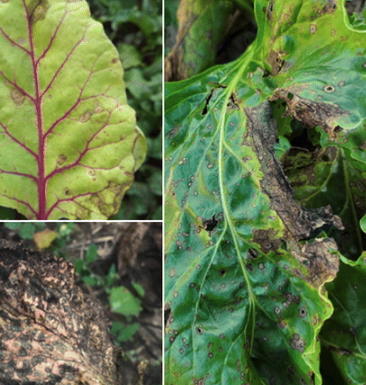Announcement of Final Thesis Defense Plant Pathology M.S. Degree Defense Seminar: Emily Jordyn Weedon
July 25, 2025 9:00AM - 10:00AM
Plant Soil Sciences Building Room A271
for zoom info contact Lauren Andring
Members of the Examining Committee and their Department:
1. Dr. Jaime Willbur - Plant, Soil and Microbial Sciences
2. Dr. Linda Hanson - Plant, Soil and Microbial Sciences
1. Dr. Timothy Miles - Plant, Soil and Microbial Sciences

ABSTRACT
Alternaria leaf spot (ALS) is caused by pathogenic fungi in the Alternaria alternata species complex and is one of the many foliar diseases impacting the domestic sugar industry in the United States. The objectives of this study were to: i) identify and characterize the pathogenic population of Alternaria spp. in Michigan sugarbeet fields through virulence assays and fungicide sensitivity screens against registered active ingredients and ii) investigate the influence of simulated overwintering conditions on fungicide resistance stability over seven months in candidate Alternaria spp. and Cercospora beticola isolates. For the first objective, Alternaria spp. isolates were collected, morphologically and molecularly identified, and then screened using a susceptible sugarbeet variety to establish baseline virulence. Of the isolates tested, 38-95% induced significant lesions when compared to the control (P < 0.05). Isolates were then screened against a panel of commercial sugarbeet varieties to assess current host resistance to ALS. Initial fungicide sensitivities were collected using a spiral gradient dilution method. Alternaria alternata isolate resistance (EC50 > 1 µg/ml) was observed for demethylation inhibitor (DMI), quinone outside inhibitor (QoI), benzimidazole, and organotin fungicides. Additionally, current varieties exhibit a range of susceptible to resistant ALS responses that did not correspond to known Cercospora leaf spot (CLS) resistance traits. For the second objective, 15 A. alternata and 13 C. beticola isolates were exposed to -20, 4, and 20°C controlled environments over the course of seven months (mimicking overwintering conditions). During this period, isolates were screened at two weeks and then subsequently every month to monitor phenotypic shifts in sensitivity to difenoconazole, tetraconazole, triphenyltin hydroxide, and thiophanate-methyl. While environment did not have a consistently significant effect on in vitro responses, time significantly influenced isolate sensitivities to difenoconazole, tetraconazole, and triphenyltin hydroxide (P < 0.05). Overall, these findings suggest that variety development and selection for robust ALS resistance, accounting for the A. alternata isolate diversity observed in the region, may be an opportunity for improving leaf spot management. Furthermore, potential shifts in A. alternata and C. beticola sensitivities to tested DMI fungicides (difenoconazole and tetraconazole) and triphenyltin hydroxide support early- and end-of-season resistance screening efforts. The information collected from these objectives is intended to inform management recommendations and enhance current practices for managing multiple prevalent leaf spot diseases.









 Print
Print Email
Email